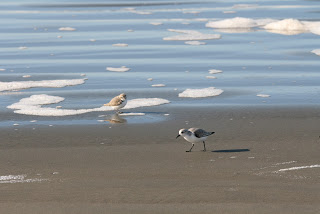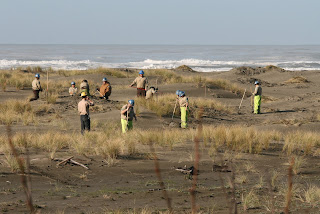On some days while walking along Clam Beach and Little River State Beach I am fortunate to see the tiny Snowy Plover crouched low and motionless among the beach debris or in a shallow depression such as a human footprint in the sand.
When I walk past them they will often move away slowly walking as though they are stiff from sitting like an old man who has been glued to his chair for hours. During the winter months they can often be seen in loose flocks.
I watched 25 Snowy Plovers recently fly before me in synchrony flashing their wing markings along the surfs edge first south then turning abruptly in unison and flying back the other way.
They all landed abruptly like leaves dropping from a tree and instantly became invisible to the untrained eye.
The above is a photo just after landing showing how well they blend in with their background appearing as beach debris.
The majority of the individuals that I see have been banded by local biologists Mark Colwell, Matt Johnson and their students at Humboldt State University who are studying them to learn more about their biology, behavior, and movements.The Pacific Coast population of the Western Snowy Plover has been listed as threatened since 1993 by the Federal Government due to declining numbers and decreased habitat as a result of introduced invasive vegetation such as European Beach grass. The Plover lays its eggs in depressions in the sand or river rock in open areas along the coast from Washington to Northern Baja, Mexico.
The threats to this “cute” sparrow sized plover are many and include natural predators like falcons, raccoons, coyotes, owls, fox, crows and ravens. The later has been determined to be the cause of most nest failures due to predation of the eggs when the parent has been disturbed.
However one of the major threats to the plover is human disturbance including Horses, bikes, vehicles, kite flying, and dogs running loose in the plovers nesting habitat.
Each time the tiny plover takes flight when disturbed they use valuable energy and often abandon their nest site making the eggs more vulnerable by increasing the opportunity for nest failure due to predation.
Much effort in cooperation with USFW and other Government agencies has been given to protect and improve the plover’s habitat.
The California Conservation Corps has been working on invasive
European Beach grass removal west of the highway 101 Vista Point overlook by digging the grass up and burning it.

The above photo looking north toward the mouth of the Little River shows the roped off area that has been restored by mechanical removal of the European Beach Grass and then restoration with native plants.
.
This work allows native plants to compete and provides a more open
foredune habitat for the Snowy Plover.
The signs at the perimeter of the roped off area at Little River State Beach
do not keep unleashed dogs from running into their habitat.
Recently my wife and I were out photographing and observing Snowy Plovers.
We observed a middle aged woman and her unleashed dog walking along the roped off area. The dog took off into the Snowy Plover protected habitat and I waved to the lady to indicate that her dog should not be there.
Her pace quickened as she approached me and she shouted "you better have a badge!" Then before I could explain why we were concerned she blurted out "I'm tired of this shit, and I'm calling 911." As she walked past us we heard her say pointing to the restoration area, "look what they've done already!"
She phoned someone while we watched her looking back at us as if we had ruined her day.
This is the challenge those of us concerned about protecting this tiny plover have when trying to educate people who simply don't care or refuse to listen to the facts. I personally feel that most people are willing to listen and learn and hopefully change.
There are volunteers who often hand out educational material but I doubt that it changes those who just don't care.
Anyone reading who would like to volunteer go here.http://www.westernsnowyplover.org/volunteering.html
I would like to hear your ideas on how best we can protect this beautiful tiny plover whose numbers are declining. Should people who ignore signs and allow their unleashed dogs to run through Snowy Plover habitat be ticketed?










